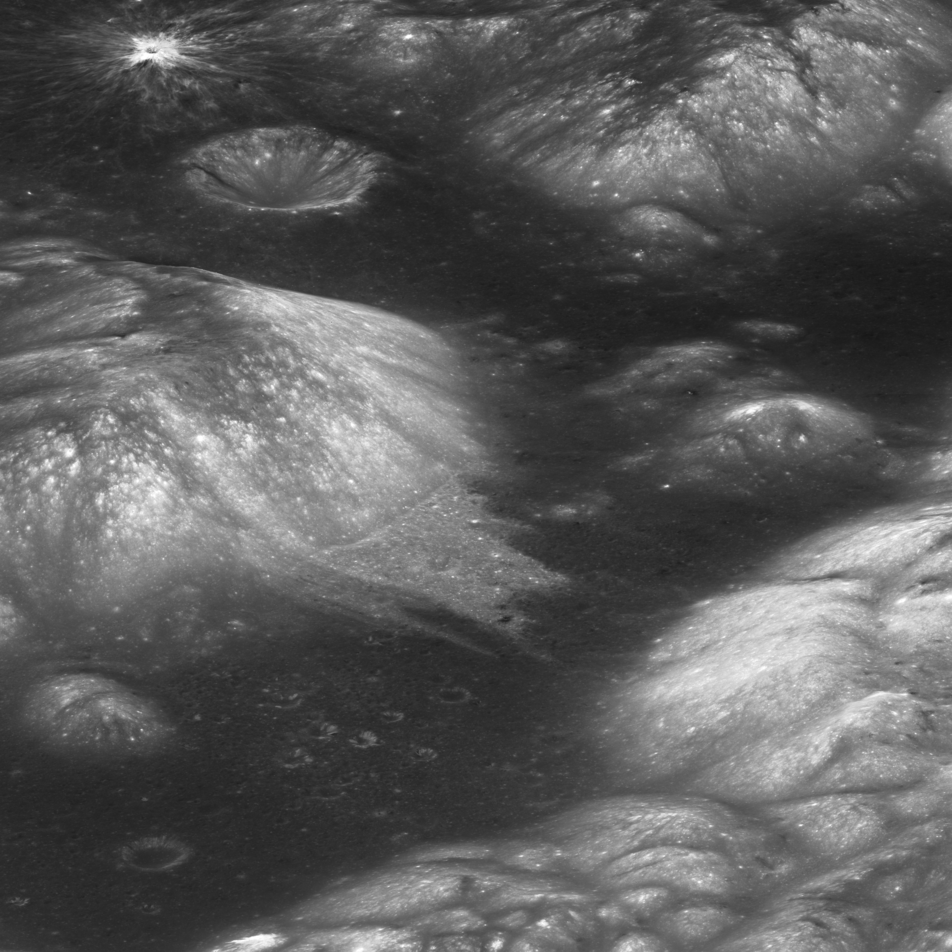
LROC team scientists, led by Prasun Mahanti, continue their quest to understand the most common class of lunar surface feature: small impact craters. The Moon lacks a protective atmosphere, so objects - mostly bits of asteroids and comets - which would form short-lived meteors or bright fireballs high in Earth's atmosphere survive to strike the Moon's surface and blast out craters. Millions upon millions of small craters pock the lunar surface.
In a paper published in the planetary science journal Icarus, the Mahanti team reported results of a study of small crater populations at two Apollo sites. The Descartes study area. centered on the Apollo 16 landing point located at 8.9734°S latitude, 15.5011°E longitude, is a highlands site astronauts John Young and Charlie Duke explored in April 1972. The Taurus-Littrow study area, centered on the Apollo 17 landing site at 20.1911°N latitude, 30.7769°E longitude, is a valley on the edge of Mare Serenitatis that astronauts Gene Cernan and Jack Schmitt explored in December 1972.
LROC has imaged the Apollo 16 and Apollo 17 sites several times under different lighting conditions. So sharp are LROC images that scientists can see the shadows cast by the American flags the astronauts planted at the sites. These images enabled Mahanti's team to examine in great detail craters measuring from 35 to 200 meters wide. The scientists studied 2568 craters at Descartes and 2543 craters at Taurus-Littrow in that size range.
The LROC scientists compared and catalogued the shape of small craters to better understand how crater degradation, or erosion, takes place in the top few meters of the regolith (surface material). They grouped the craters into three basic classes based on shape. "A" craters are the least degraded, with sharp rims and bowl-shaped interiors. "C" craters are the most degraded, with no rims and shallow, funnel-shaped profiles. "B" craters fall in-between. They have rims lower than "A" craters and are more bowl-shaped than "C" craters. The shapes indicate how much degradation has taken place.


At the Apollo 16 site, degraded "C" craters far outnumber the other types, making up slightly more than 70% of the total. Fresh "A" craters, by contrast, make up to a little less than 3% of the total. The rest of the craters at Descartes are intermediate "B" types.
When the scientists compared the small craters at Descartes with those on Taurus-Littrow's mostly flat valley floor, they found a mystery. Small craters at the Apollo 17 site are generally more degraded than at the Apollo 16 site, with 88% falling into the "C" group. In other words, degradation does not occur at the same rate at the two sites. In addition to processes that affect small craters everywhere on the Moon, there must be local processes that affect the rate of small crater degradation.
In their Icarus paper, the scientists suggested two main explanations for why the small craters degrade at different rates between the two sites.
First, the physical properties of the regolith varies from place to place across the Moon. Taurus-Littrow regolith might be softer or more slippery, say, making it more prone to movement that could rapidly transform fresh "A" craters into degraded "C" craters.
Second, the Apollo 17 site might have been subjected to more of the processes scientists believe are responsible for actively degrading small craters, such as moonquakes. The Lee-Lincoln scarp is a tectonic fault a few kilometers from where Apollo 17 landed. Crust movement along the fault might periodically shake Taurus-Littrow, causing regolith in the small crater rims and bowl-shaped floors to slip and slump faster than in areas far from large faults.
Taurus-Littrow also has a cluster of craters believed to have been formed by material flung out from the formation of 86-kilometer-wide Tycho crater about 100 million years ago. Tycho is 2250 kilometers from Taurus-Littrow, but the impact that formed it was violent enough that it cast material far across the Moon. Impact of Tycho material on the valley floor would have caused local moonquakes, again hastening the degradation of small craters.
Which site is better representative of small crater degradation rates across the whole Moon? The lunar science community continues its research into the forces that degrade small lunar craters. Soon, the Mahanti team will present a comparison of the Descartes and Taurus-Littrow small crater populations and the small craters at the four other Apollo landing sites. Six study sites are better than two for understanding a process that affects the entire Moon. Please stay tuned!
Full oblique image centered on Taurus-Littrow valley; when zoomed out, Clerke crater (6.7-kilometer diameter) is prominently visible in the upper right corner. Image is 62 km wide, image M1182232465LR [NASA/GSFC/Arizona State University].
Pan and zoom around Apollo 16's Descartes landing site to inspect the many small impact craters - fresh, partly degraded, and heavily degraded - the LROC scientists catalogued and classified. The Apollo 16 landing site is visible in this wilderness of craters and rolling hills - can you spot the hardware the astronauts left behind and their dark trackways? Center latitude 8.9734°S, center longitude 15.5011°, total image width is 4200 meters, image NAC M152770233LR [NASA/GSFC/Arizona State University].
For all the details on this ongoing study. read the recently published Icarus paper online: Mahanti, P., Robinson, M. S., Thompson, J. R., and Henriksen, M. R., "Small lunar craters at the Apollo 16 and 17 landing sites - morphology and degradation," Icarus, 299 (2018), 475-501, http://dx.doi.org/10.1016/j.icarus.2017.08.018
Related Featured Images
Probing the Lunar Surface Using Small Impact Craters
Spacecraft-Related Coordinates - 2016 Update
Dynamic Moon!
Regolith Porosity from Lunar Orbit
Astronaut's Eye View of Apollo 16 Site
Fresh But Not So Clean
Published by David Portree on 24 April 2018